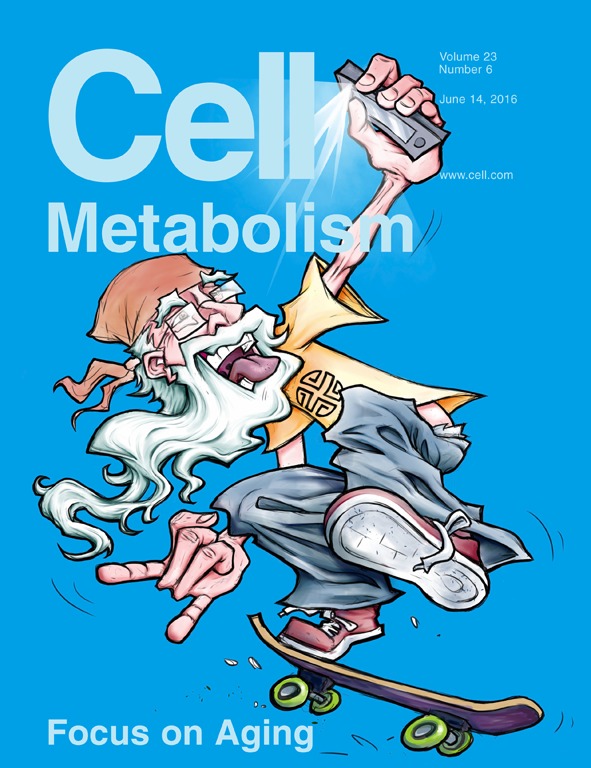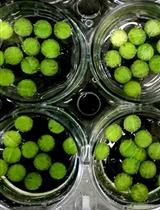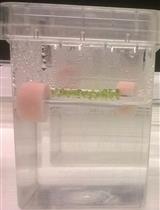- EN - English
- CN - 中文
Two Different Methods of Quantification of Oxidized Nicotinamide Adenine Dinucleotide (NAD+) and Reduced Nicotinamide Adenine Dinucleotide (NADH) Intracellular Levels: Enzymatic Coupled Cycling Assay and Ultra-performance Liquid Chromatography (UPLC)-Mass Spectrometry
定量氧化烟酰胺腺嘌呤二核苷酸(NAD+)和还原型烟酰胺腺嘌呤二核苷酸(NADH)细胞内水平的两种不同方法:酶联偶合循环测定和超高效液相色谱(UPLC)-质谱分析法
(*contributed equally to this work) 发布: 2018年07月20日第8卷第14期 DOI: 10.21769/BioProtoc.2937 浏览次数: 8824
评审: Andrea PuharNeelanjan BoseAnonymous reviewer(s)
Abstract
Current studies on the age-related development of metabolic dysfunction and frailty are each day in more evidence. It is known, as aging progresses, nicotinamide adenine dinucleotide (NAD+) levels decrease in an expected physiological process. Recent studies have shown that a reduction in NAD+ is a key factor for the development of age-associated metabolic decline. Increased NAD+ levels in vivo results in activation of pro-longevity and health span-related factors. Also, it improves several physiological and metabolic parameters of aging, including muscle function, exercise capacity, glucose tolerance, and cardiac function in mouse models of natural and accelerated aging.
Given the importance of monitoring cellular NAD+ and NADH levels, it is crucial to have a trustful method to do so. This protocol has the purpose of describing the NAD+ and NADH extraction from tissues and cells in an efficient and widely applicable assay as well as its graphic and quantitative analysis.
Background
Oxidized Nicotinamide adenine dinucleotide and reduced nicotinamide adenine dinucleotide (NAD+ and NADH) are important biological cofactors that donate and accept electrons in several anabolic and catabolic functions. They participate in reactions such as glycolysis, the tricarboxylic acid cycle, and oxidative phosphorylation. In addition, it serves as a substrate for several enzymes involved in DNA damage repair, such as the sirtuins and poly (ADP-ribose) polymerases (PARPs) (Imai and Guarente, 2014; Verdin, 2015; Yoshino et al., 2018).
NAD+ levels decrease during aging and are involved in age-related metabolic decline. It has been shown that the cellular NAD pool is determined by a balance between the activity of NAD-synthesizing and NAD-consuming enzymes (Aksoy et al., 2006; Barbosa et al., 2007; Yang et al., 2007; Nahimana et al., 2009; Bai et al., 2011; Yoshino et al., 2011). In previous publications, our laboratory has demonstrated that expression and activity of the NADase CD38 increases with age and that CD38 is required for the age-related NAD decline and mitochondrial dysfunction via a pathway mediated at least in part by regulation of SIRT3 activity (Camacho-Pereira et al., 2016). We also identified CD38 as the main enzyme involved in the degradation of the NAD precursor nicotinamide mononucleotide (NMN) in vivo. That indicates that CD38 has a key role in the modulation of NAD-replacement therapy for aging and metabolic diseases (Camacho-Pereira et al., 2016). CD38 was originally identified as a cell-surface enzyme that plays a key role in several physiological processes such as immune response, inflammation, cancer, and metabolic disease (Frasca et al., 2006; Barbosa et al., 2007; Guedes et al., 2008; Malavasi et al., 2008).
Several different assays and methods have been described due to the great importance of monitoring NAD+ and NADH cellular levels under various physiological conditions. Specifically two of them, ultra-performance liquid chromatography (UPLC)-mass spectroscopy assay and cycling assay have finality and both are equally sensitive and specific (Camacho-Pereira et al., 2016).
Our laboratory also further optimized and validated the cycling assay. We determined NAD+ and NADH specific and does not detect any of the other nucleotides or NAD derivatives tested, including nicotinamide adenine dinucleotide phosphate (NADP), nicotinic acid adenine dinucleotide (NAAD), nicotinic acid adenine dinucleotide phosphate (NAADP), cyclic-adenine diphosphate ribose (cADPR), adenine triphosphate (ATP), ADP, and others. The results obtained with both methods confirm that there is indeed a decrease in levels of both NAD+ and NADH in murine tissues during chronological aging (Camacho-Pereira et al., 2016). Furthermore, both techniques correlated well for both nucleotides (correlation coefficient of r = 0.95 for NAD+ and 0.97 for NADH) (Camacho-Pereira et al., 2016).
In regards to the cycling assay (pathway in which the main reaction happens), it takes NAD+ and NADH present in the samples and they are coupled to both enzymes alcohol dehydrogenase (ADH) and diaphorase in a cycling assay. Every time NAD+ or NADH cycles, it produces a molecule of resorufin, which is highly fluorescent. This fluorescence is directly captured by the multi-well fluorescence plate reader therefore indirectly the NAD+ levels can be measured. Most studies have relied on separated extractions for NAD+ and reduced nicotinamide adenine dinucleotide (NADH) determination: a basic extraction for the reduced species and a separate acidic extraction for the oxidized species (Ashrafi et al., 2000; Smith et al., 2000; Lin et al., 2001; Anderson et al., 2002; Lin et al., 2004). The extraction conditions are specific for the stabilization of either oxidized compounds, which are more stable in acid or reduced compounds, which are more stable in base.
Conversely, the ultra-performance liquid chromatography (UPLC)-mass spectrometry is an analytical chemistry technique that combines the physical separation capabilities of liquid chromatography with the mass analysis capabilities of mass spectrometry (MS). MS systems are popular in chemical analysis because the individual capabilities of each technique are enhanced synergistically. While liquid chromatography separates mixtures with multiple components, mass spectrometry provides identity of the individual components with high molecular specificity and detection sensitivity. This tandem technique can be used to analyze very accurate components such as NAD+ and NADH (Dass, 2007).
Part I: Cycling assay
Materials and Reagents
- Plastic tips 10 (Thermo Fisher Scientific, Molecular Bioproducts, catalog number: 3511-05 )
- Plastic tips 1,000 (Thermo Fisher Scientific, Molecular Bioproducts, catalog number: 3101 )
- Plastic tips 200 (Thermo Fisher Scientific, Molecular Bioproducts, catalog number: 3551 )
- 1.5 ml Microcentrifuge tubes (USA Scientific, catalog number: 1415-2508 )
- 2.0 ml MCT Graduated tubes (Fisher Scientific, Fisherbrand, catalog number: 05-408-146 )
- 96-well Microfluor 1White flat-bottom plate (Thermo Fisher Scientific, catalog number: 7705 )
- Combitips Advanced 10 ml (Eppendorf, catalog number: 0030089464 )
- Disposable cell lifter (Fisher Scientific, Fisherbrand, catalog number: 08-100-240 )
- Cells of interest: any cell can be used to measure NAD+/NADH levels
- Tissues of interest: any tissue can be used to measure NAD+/NADH levels
- Trichloroacetic Acid (TCA) (Sigma-Aldrich, catalog number: T4885-500G )
- Sodium hydroxide (NaOH) 10 N (Fisher Scientific, Fisher Chemical, catalog number: SS267 )
- Ethylenediaminetetraacetic acid (EDTA) (Sigma-Aldrich, catalog number: E5134 )
- Bio-Rad Protein Assay Dye Reagent Concentrate (Bio-Rad Laboratories, catalog number: 5000006 )
- 1,2,2-Trichlorotrifluoroethane (TCTFE) (Fisher Scientific, Fisher Chemical, catalog number: T1781 )
- Trioctylamine (Sigma-Aldrich, catalog number: T81000-500G )
- Tris base, Trizma base (Sigma-Aldrich, catalog number: T6066 )
- Diaphorase (Sigma-Aldrich, catalog number: D5540-500UN )
- Alcohol dehydrogenase (ADH) (Sigma-Aldrich, catalog number: A3263-75KU )
- Activated charcoal (Sigma-Aldrich, catalog number: C7606-125G )
- Sodium phosphate monobasic (NaH2PO4) (Sigma-Aldrich, catalog number: S0751-500G )
- Sodium phosphate dibasic (Na2HPO4) (Sigma-Aldrich, catalog number: S0876-500G )
- Absolute Ethanol (Fisher Scientific, Fisher BioReagentsTM, catalog number: BP2818-500 )
- Bovine Serum Albumin (Sigma-Aldrich, catalog number: A7906 )
- β-NAD sodium salt (Sigma-Aldrich, catalog number: N0632-1G )
- Riboflavin 5’-monophosphate sodium salt hydrate (FMN) (Sigma-Aldrich, catalog number: F8399 )
- Resazurin sodium salt (Sigma-Aldrich, catalog number: 199303-5G )
- Phosphate-buffered saline (PBS – pH 7.4) (Thermo Fisher Scientific, GibcoTM, catalog number: 10010023 )
- Organic solvent (see Recipes)
- Sodium Phosphate Buffer (pH 8.0) (see Recipes)
- 20 mM Sodium Phosphate Buffer (pH 7.0) (see Recipes)
- 4% charcoal suspension (in 20 mM sodium phosphate, pH 7.0) (see Recipes)
- Bradford Dye (see Recipes)
- Tris Buffer (1 M, pH 8.0) (see Recipes)
Equipment
Note: The brands and models indicated are the ones used by our group, similar equipment can be used as well.
- 1 L volumetric flask
- Pipettes (10, 200, 1,000 µl)
- Repeat Pipette (Eppendorf, model: Repeater® M4 )
- Scissors
- Homogenizer, Tissue Tearor (Bio Spec Products, catalog number: 780CL-04 )
- Microcentrifuge (Eppendorf, model: 5424 )
- Scale (Mettler-Toledo International, model: AG104 )
- Sonic Dismembrator (Fisher Scientific, model: Model 100 )
- Vortex (Scientific Industries, model: Vortex-Genie 2 , catalog number: G560)
- -80 °C freezer
- Plate reader (Molecular Devices, model: SpectraMax® GeminiTM XPS )
- Spectrophotometer (BioTek Instruments, model: Epoch 2 )
Software
- Gen5 Microplate Reader and Imager Software (BioTek Instruments)
- Microsoft Excel (Microsoft Corporation)
- SoftMax Pro 6 (Molecular Devices, LLC)
- GraphPad Prism 7 (GraphPad Software, Inc)
Procedure
文章信息
版权信息
© 2018 The Authors; exclusive licensee Bio-protocol LLC.
如何引用
Kanamori, K. S., de Oliveira, G. C., Auxiliadora-Martins, M., Schoon, R. A., Reid, J. M. and Chini, E. N. (2018). Two Different Methods of Quantification of Oxidized Nicotinamide Adenine Dinucleotide (NAD+) and Reduced Nicotinamide Adenine Dinucleotide (NADH) Intracellular Levels: Enzymatic Coupled Cycling Assay and Ultra-performance Liquid Chromatography (UPLC)-Mass Spectrometry. Bio-protocol 8(14): e2937. DOI: 10.21769/BioProtoc.2937.
分类
生物化学 > 其它化合物 > NAD+/NADH
您对这篇实验方法有问题吗?
在此处发布您的问题,我们将邀请本文作者来回答。同时,我们会将您的问题发布到Bio-protocol Exchange,以便寻求社区成员的帮助。
Share
Bluesky
X
Copy link














